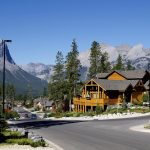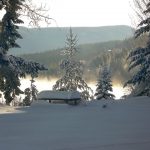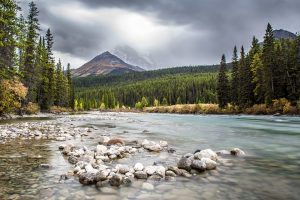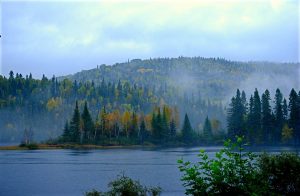Brief History of Wood Buffalo
The Regional Municipality of Wood Buffalo, usually referred to as Wood Buffalo, first originated when it became a part of the North-West Territories. This occurred in the late 1800s and would continue to be until the early 1900s. From then on, Wood Buffalo has been a part of Alberta since it became a province in 1905. This area has seen significant development over its lifetime, largely due to its vast resources, including fur, oil, and gas.
Following its time as a fur trade hub, a major turning point for Wood Buffalo was when oil sands were discovered in the region. This attracted a significant amount of workers and industry to the area, leading to its growth and development. In 1995, the Regional Municipality of Wood Buffalo was established combining Fort McMurray and surrounding areas.
Geographical Location and Climate
Wood Buffalo is situated in northeast Alberta. It spans a vast territory of nearly 70,000 square kilometers, which includes a variety of landscapes such as boreal forests, wetlands, and oil sand deposits. The municipality is also interspersed with several rivers, including the Athabasca Athabasca Origins & Evolution Nestled in the heartland of Alberta, Canada lies the tranquil and fertile city of Athabasca, a community rooted in traditional values and progressive ideals. Originally established in 1913, the city's moniker was derived from the Cree word "aðapaskāw," which directly translates as "[where] there are plants one after another," providing hints to the city's agricultural beginnings.... and Clearwater
Athabasca Origins & Evolution Nestled in the heartland of Alberta, Canada lies the tranquil and fertile city of Athabasca, a community rooted in traditional values and progressive ideals. Originally established in 1913, the city's moniker was derived from the Cree word "aðapaskāw," which directly translates as "[where] there are plants one after another," providing hints to the city's agricultural beginnings.... and Clearwater Clearwater Origins & Evolution Nestled near the junction of the North and South Thompson Rivers, Clearwater was originally inhabited by the Simpcw, a division of the Secwepemc, or Shuswap, people. It wasn't until the late 19th-century that European settlers arrived, eventually leading to the city's development. The town was officially established in 1916, named after Clearwater River that runs through... rivers.
Clearwater Origins & Evolution Nestled near the junction of the North and South Thompson Rivers, Clearwater was originally inhabited by the Simpcw, a division of the Secwepemc, or Shuswap, people. It wasn't until the late 19th-century that European settlers arrived, eventually leading to the city's development. The town was officially established in 1916, named after Clearwater River that runs through... rivers.
The area experiences a subarctic climate. Summers are short and warm, whereas winters are predominately cold and long. Snow typically covers the region from October to April, and the Northern Lights can frequently be seen during the clear, dark winter nights.
Population and Demography
Wood Buffalo is not a typical city, but rather a region made up of several communities. Fort McMurray is the largest community and serves as the urban service area for the municipality. The region was home to just over 111,000 residents in the 2018 census, about two-thirds of whom live in Fort McMurray. The rest of the population is scattered among smaller communities and rural areas.
The population is culturally diverse, with immigrants and citizens from different ethnic backgrounds. This diversity contributes to the rich cultural fabric of the city.
Founding of the City and Its Historical Development
The city was founded as a fur trading post in the late 18th century and evolved over time due to exploitation of the region’s natural resources. From the 1940s onwards, the area began seeing significant development due to oil sands extraction.
In recent decades, Wood Buffalo’s population has exploded in tandem with the rapid growth of oil sands production. This has resulted in new neighborhoods, facilities, and infrastructure being built to accommodate the surging population.
Cultural Events and Festivals
The area hosts a variety of annual events that serve to highlight the unique cultural blend of Wood Buffalo. Events such as the Northern Lights Bluegrass and Old Tyme Music Festival, the interPLAY Film Festival, and the Wood Buffalo Brewing Company’s Beerfest are some of the key events highlighting local music, film, and beer culture respectively.
Museums, Theaters, and Galleries
The Oil Sands Discovery Centre and the Fort McMurray Heritage Society, both located in Fort McMurray, provide insight into the historical, cultural and economic development of the region. Additionally, theatre and arts are represented by Keyano Theatre and Arts Centre, which hosts a variety of performances throughout the year.
Universities and Scientific Institutions
Keyano College serves as the region’s post-secondary institution, which offers various programs training the local workforce. The college also works closely with industry partners and other post-secondary institutions to ensure the educational needs of the region are met.
Libraries and Research Centers
Wood Buffalo Regional Library, located in MacDonald Macdonald Origins & Evolution Rooted in rich history, Macdonald originated as a farming community in the 19th century. Over the years, it has developed into a thriving city that has preserved its history while embracing the developments of the modern world. Initially, it was named after the Canadian politician and first Prime Minister Sir John A. Macdonald. The city has... Island Park, provides a wide array of services and resources to residents of the region.
Macdonald Origins & Evolution Rooted in rich history, Macdonald originated as a farming community in the 19th century. Over the years, it has developed into a thriving city that has preserved its history while embracing the developments of the modern world. Initially, it was named after the Canadian politician and first Prime Minister Sir John A. Macdonald. The city has... Island Park, provides a wide array of services and resources to residents of the region.
In terms of research centers, the region benefits from the proximity of the Alberta Oil Sands Technology and Research Authority, focused on developing sustainable technologies for oil sands extraction.
Significant Landmarks and Monuments
One of the region’s most significant landmarks is Syncrude’s Giants of Mining, a collection of three gargantuan sculptures representing the enormous machinery used in oil sand extraction. Furthermore, the Abasand ruins – the remnants of an oil extraction plant destroyed during World War II – serves as a unique historical monument.
Parks, Gardens and Open Spaces for Recreation
The region boasts several parks and recreation areas such as the Birchwood trail Trail Origins & Evolution The city of Trail, situated in British Columbia, Canada, holds a rich history that traces its roots to the 19th century. The city was founded by prospectors during the Gold Rush era, enticed by its bountiful deposits of minerals, mainly gold, silver, and copper. Later, the thriving mining industry prompted the construction of the Trail Smelter,... network, MacDonald Island Park, and the Gregoire Lake Provincial Park. These spaces provide opportunities for residents and visitors to engage in various recreational activities.
Trail Origins & Evolution The city of Trail, situated in British Columbia, Canada, holds a rich history that traces its roots to the 19th century. The city was founded by prospectors during the Gold Rush era, enticed by its bountiful deposits of minerals, mainly gold, silver, and copper. Later, the thriving mining industry prompted the construction of the Trail Smelter,... network, MacDonald Island Park, and the Gregoire Lake Provincial Park. These spaces provide opportunities for residents and visitors to engage in various recreational activities.
Public Transportation and Transportation Infrastructure
Wood Buffalo Transit provides public transportation within Fort McMurray. Moreover, Alberta Highway 63 is the major road artery serving the municipality, connecting it to other parts of the province.
Airports, Rail and Bus Stations
Fort McMurray International Airport serves the region offering domestic flights to many Canadian cities. However, there are no passenger rail services available in the municipality.
Stadiums and Sports Facilities
MacDonald Island Park is a major sports complex in the region, featuring facilities for swimming, golfing, and more. Additionally, the Casman Centre is a popular venue for concerts and events and home to the Oil Barons, a Junior A hockey team.
Wrap Up
Wood Buffalo is a region rich in history and culture, rooted in its significant contributions to Canada’s oil industry. Its standout attributes are its vast natural landscapes, a diverse population, strong local economy, and extensive recreational activities. It offers a unique blend of urban living within a larger rural landscape.
Attractions and landmarks mentioned:
- Oil Sands Discovery Centre
- Keyano Theatre and Arts Centre
- Alberta Oil Sands Technology and Research Authority
- Syncrude’s Giants of Mining
- Birchwood trail network
- MacDonald Island Park
- Gregoire Lake Provincial Park
- Fort McMurray International Airport
- Casman Centre










